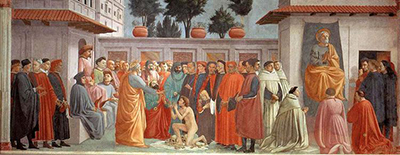The captivating artwork by renowned artist Masaccio interprets an array of form to illuminate the scenery within the painting.
The artwork showcases a horizontal scenery from a biblical story that illustrates the welcoming of the son of Teophilus. The focal point of the artwork is illustrated within the middle of the painting as he kneels on his left knee while folding his other leg. The man is portrayed nude upon a white cloth covered in human skulls and remains.
The interesting scenery illustrated by the artist showcases an in depth analysis of the plot that the viewer is meant to uncover. As the man kneels in front of the king nude, arrays of questions begin to arise; regarding why the son of Teophilus begs for forgiveness. The mysterious scene depicted within the artwork showcases difficult questions for the viewer to uncover.
The seizing element of the artwork is the way in which the king holds his hand open against the man as he begs for forgiveness. The body language of this ruler illustrates his dominance over the man, and his anger as he halts apology. This powerful event showcases a critical power dynamic between the two characters, allowing the viewer and insight towards history.
While this event stands as the focal point of the left side of the painting, an additional story occurs near the right of the artwork as St. Peter is enthroned and placed as a hierarchy upon others. The pure soul is depicted against a grey fabric, as he is hung against a white marble wall while people bow down before him.
His saintly presence is one that seized the population as they pray to his pure form, asking for forgiveness and thanks. MasaccioÕs impeccable ability to display two significant events within one painting is showcased within the artwork as the viewer must analyze all events taking place.
The artist had often went further to display an array of unknown figures within the background in order to add to the curiosity of the painting. This is evident within Distribution of Alms and Death of Ananias, Baptism of Neophytes, and Adoration of Kings. This method had incredibly benefited the artistÕs work as it makes the scene seem more important as people gather to view the events.
Within the painting the viewer is able to witness an array of upper class society members gathering around the betrayal of the son of Teophilus, and the honoring of St. Peter. The citizens within the artwork add to the mystery behind the painting as critics wonder what the symbolisms behind the events were.
These individuals are painting wearing luxurious clothing, as they are religious figures within the church, servants of the King, and prominent colleagues of the kingdom. These individuals are dressed in rich textiles, from lush shades of pink and purple, to classic white and blacks, and prominent reds. The character's attire covers their bodies as their silhouette is seized in this array of colour.
The setting of the artwork seems to be based in the rich kingdom of the royal family. Wealthy white marble line the walls as the area in which the people gather seems to resemble an outdoor space.
Classic aspects of the architecture at the time were the deep orange shades that lined the perimeter of structures in order to add detail to the work. This technique is evident throughout the painting as the white marble is accentuated through these natural shades. The viewer is greeted with a glimpse view of the light blue sky, covered in green palm trees lining the sky.




